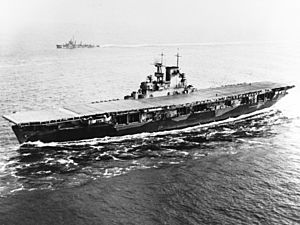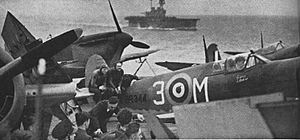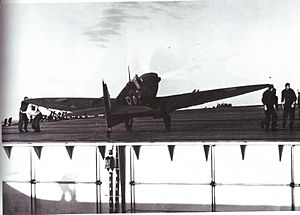Operation Bowery facts for kids
Operation Bowery was an important mission during World War II. It was a joint effort by American and British forces. Their goal was to deliver Spitfire fighter planes to the island of Malta. These planes were desperately needed to defend Malta from strong air attacks by the Axis.
Contents
Why Malta Needed Help
Malta is a small island in the Mediterranean Sea. During World War II, it was a very important base for the Allies. The Axis (Germany and Italy) wanted to capture Malta. They launched many air raids to bomb the island.
Malta needed more fighter planes to defend itself. Before Operation Bowery, there was a similar mission called Operation Calendar. The American aircraft carrier USS Wasp delivered 48 Spitfires then. However, many of those planes were destroyed on the ground. This happened because the airfields were not ready. Also, the Axis forces knew the planes were coming.
So, a new mission, Operation Bowery, was planned. Its success was even more important for the Allies. They had to make sure the planes would survive this time.
The Bowery Mission Begins
The USS Wasp returned to Glasgow, Scotland, on April 29, 1942. There, it loaded 47 Spitfire Mk Vc planes. These planes were loaded at the King George V dock.
There was a big problem with the planes' long-range fuel tanks. They did not fit well and leaked fuel. The captain of the Wasp, Captain Reeves, stopped loading. He insisted the problem be fixed. His own crew helped fix some of the tanks. This was embarrassing for the British. They had known about this problem from the earlier mission.
The Wasp and its escort ships, called Force W, sailed on May 3. Another British aircraft carrier, HMS Eagle, joined them. The Eagle carried 17 more Spitfires. These planes had been delayed from earlier missions.
On May 9, 1942, 64 Spitfires took off from the USS Wasp and HMS Eagle. Almost all of them, 61 planes, arrived safely in Malta. Sadly, one plane and its pilot were lost during takeoff.
An Amazing Landing
One pilot, Canadian P/O Jerrold Alpine Smith, had a problem. His long-range fuel tank stopped working after takeoff. He could not reach Malta. So, he dropped the faulty tank. He then circled back to the Wasp.
With permission from the ship's captain, he landed his Spitfire back on the carrier. This was the first time a Spitfire had ever landed on an aircraft carrier! It was called "A Feat Unparalleled" by a top British Air Commander. P/O Smith was even unofficially given American Navy Wings.
The Speedy Welshman
At the same time, a British ship called HMS Welshman also helped Malta. It was a minelayer, but it was used to carry supplies. The Welshman made a very fast trip to Malta. It carried food, general supplies, and 100 spare Merlin aircraft engines. It also carried RAF ground crews trained to work on Spitfires.
The Welshman was disguised as a French destroyer. It traveled alone. German aircraft stopped and checked the Welshman twice. But the ship looked peaceful and was allowed to pass. It reached Malta at sunrise on May 10. The ship unloaded its cargo during a heavy air raid. It was even damaged by falling debris. Despite this, it left Malta that same evening. It arrived back in Gibraltar on May 12.
Malta's Defense and Victory
On Malta, important lessons had been learned from the earlier disaster. This time, detailed plans were made. The goal was to get the Spitfires into the air quickly. When the planes landed, they were immediately moved to safe areas. They were refueled and rearmed very fast. Some planes were ready in just six minutes!
The newly arrived fighters, with fresh pilots, were soon flying over Malta. They were waiting for the expected air raid. An Italian formation of bombers and fighters attacked. The Spitfires intercepted them. The Allies claimed 47 enemy aircraft were destroyed or damaged. The British lost only three planes.
This air battle, sometimes called the "Battle of Malta," was a turning point. It stopped the daytime bombing of Malta almost completely. The defenders of Malta received even more aircraft in May and June. Also, some German Luftwaffe planes were moved to Russia. This helped Malta keep its strong defense.




